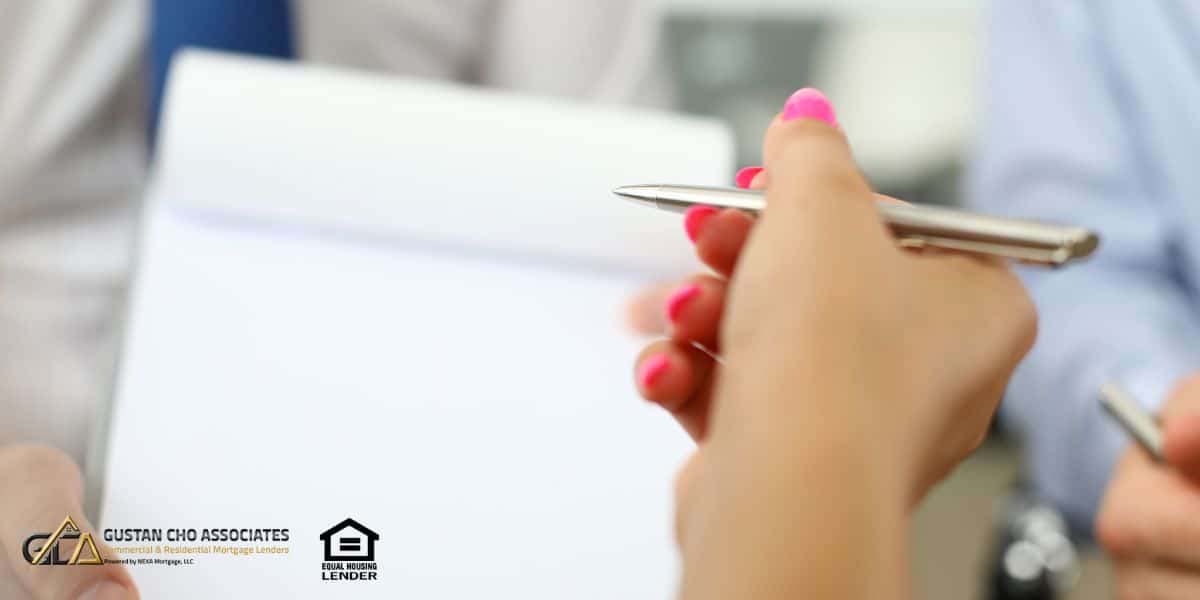Understanding DTI Manual Underwriting Guidelines for FHA, VA, Non-QM, and Alternative Loans (2025 Update)
Debt-to-income (DTI) manual underwriting guidelines are critical for borrowers who may not qualify through automated systems but want to achieve their dream of homeownership. Whether you’re applying for an FHA loan, a VA loan, or a non-QM loan, manual underwriting can open doors when others are closed.
Gustan Cho Associates specializes in helping borrowers navigate these guidelines and secure financing tailored to their unique situations.
In this updated 2025 guide, we’ll explain everything you need about DTI manual underwriting guidelines, including FHA and VA loans, non-QM loans, and alternative financing options. You’ll also learn how compensating factors can boost your approval chances, even with high DTI ratios.
What Are DTI Manual Underwriting Guidelines?
Lenders look at debt-to-income (DTI) ratios to determine if you can afford a mortgage. Manual underwriting means a human underwriter reviews your financial details instead of using automated systems like Desktop Underwriter (DU) or Loan Product Advisor (LPA). For more information on automated underwriting systems (AUS), check out our AUS BLOG.
The DTI Manual Underwriting Guidelines were created after the 2008 real estate downturn. The government responded to this crisis by introducing the Ability to Repay Act. For more details about the Ability to Repay Act, visit the CFPB website.
If you don’t get automated approval because of high DTI, unique income situations, or credit issues, you may still qualify for a mortgage under the DTI manual underwriting guidelines.
Key Features of Manual Underwriting:
- Stricter DTI ratio limits.
- More emphasis is placed on compensating factors like reserves and job stability.
- Borrowers with distinct financial situations, including self-employed persons or individuals who have experienced recent credit events, can benefit from increased flexibility.
Manual Underwriting Can Help You Qualify with Higher DTI
If you’ve been denied by AUS, don’t give up—manual underwriting gives you a second chance.
FHA Loans and DTI Manual Underwriting Guidelines
When it comes to loans backed by the government, FHA loans are a top choice for people who need manual underwriting. This means that the loan guidelines can be a bit more flexible. FHA loans are great for borrowers with low credit scores, high DTI (debt-to-income) ratios, or even no credit history. The DTI manual underwriting guidelines let lenders consider more than just numbers, making it easier for some folks to get approved.
Home buyers may be eligible for an FHA Loan immediately following the discharge of a Chapter 13 Bankruptcy through manual underwriting.
Maximum DTI Ratios for FHA Manual Underwriting (2025):
- 31/43%: No compensating factors.
- 37/47%: One compensating factor (e.g., reserves or job stability).
- 40/50%: Two or more compensating factors.
Compensating Factors That Can Boost Approval:
- Three months of reserves for 1-2 unit properties.
- Low payment shock (less than a 5% increase in housing costs).
- Residual income exceeding guideline thresholds.
- A stable, long-term employment history.
- Income from a spouse who is not listed on the mortgage loan
Case Example: Sarah, with a credit score of 580, has a DTI of 39/48%. She didn’t qualify through the automated underwriting system (AUS), but her $10,000 in reserves and 10-year job history helped her secure manual underwriting approval for an FHA loan.
VA Loans and DTI Manual Underwriting Guidelines
VA loans provide great advantages for veterans and active-duty military personnel. One key difference from FHA loans is that VA loans don’t have strict requirements for your debt-to-income (DTI) ratio. Instead of just looking at how much you owe compared to how much you earn, they pay more attention to your residual income—the money you have left after paying all your bills. This approach can make qualifying borrowers easier, especially under DTI manual underwriting guidelines.
VA Manual Underwriting Guidelines (2025):
- Residual Income: Borrowers must meet regional residual income standards.
- DTI Threshold: While there is no official maximum, 41% is generally considered the benchmark. Exceptions can be made with strong compensating factors.
Common Compensating Factors for VA Loans:
- High residual income.
- Significant cash reserves.
- A proven track record of timely housing payments.
Case Example: John, a veteran, had a back-end DTI of 55%. Despite being above the recommended 41%, his $20,000 in residual income and history of on-time rent payments helped him secure manual underwriting approval for a VA loan.
Manual Underwriting for FHA and VA Loans Made Simple
We specialize in manual underwriting approvals for high DTI borrowers with stable income and solid credit.
Non-QM Loans and DTI Manual Underwriting Guidelines
Non-QM loans (non-qualified mortgages) cater to borrowers who don’t fit traditional lending criteria. These loans are ideal for self-employed individuals, investors, or those with complex income structures. While non-QM loans typically don’t require manual underwriting, some lenders may review applications manually for borrowers with high DTIs or unconventional financial profiles.
Non-QM Manual Underwriting Features:
- Flexible DTI limits (up to 50-55% in many cases).
- Alternative forms of income verification include documents like bank statements or profit-and-loss reports.
- Minimal credit score requirements in some cases.
Common Non-QM Loan Programs:
- Bank Statement Loans: Evaluate deposits instead of tax returns.
- Debt-Service Coverage Ratio (DSCR) Loans: Focus on rental income to qualify.
- Asset-Based Loans: Rely on liquid assets rather than income.
Case Example: Mary, a self-employed borrower, had a DTI of 50% and inconsistent tax returns. Using 12 months of bank statements to document her income, she qualified for a non-QM loan through manual underwriting.
Alternative Loan Programs for Unique Borrowers
In addition to FHA, VA, and non-QM loans, several alternative loan programs cater to borrowers needing manual underwriting:
ITIN Loans: These loans are for individuals who may not have a Social Security number but have an Individual Taxpayer Identification Number (ITIN). For example, a Mexican immigrant living in the U.S. for work can use an ITIN loan to buy their first home, even though they don’t have a Social Security number.
Foreign National Loans: These loans cater to non-residents who want to invest in U.S. real estate. For instance, a Canadian investor looking to purchase a vacation home in Florida can apply for a foreign national loan, even though they don’t live in the U.S. full-time.
Hard Money Loans: These loans are great for real estate investors who may not have all the regular paperwork needed for a mortgage. A house flipper who wants to quickly buy a rundown property might use a hard money loan. This loan lets them get financing based on the property’s value, not their income or credit score.
These loans offer alternatives for individuals who face difficulties obtaining funding through conventional means.
How Mortgage Underwriters Calculate Debt-to-Income Ratios
For DTI manual underwriting guidelines, lenders check two different ratios:
- Front-End Ratio: Housing expenses divided by gross monthly income.
- Back-End Ratio: Housing expenses + all other monthly debts divided by gross monthly income.
Example: If you earn $5,000/month, have $1,800 in housing expenses, and $700 in other debts:
- Front-End DTI: $1,800 / $5,000 = 36%
- Back-End DTI: ($1,800 + $700) / $5,000 = 50%
Advantages of Manual Underwriting
- Human Discretion: Unlike automated systems, DTI manual underwriting guidelines allow underwriters to evaluate your financial story holistically.
- Compensating Factors: Strong reserves, job stability, or residual income can help offset high DTIs or credit challenges.
- Flexibility: Manual underwriting accommodates unique borrowers, such as those with non-traditional income or credit profiles.
Challenges of Manual Underwriting
- Stricter Guidelines: Higher standards for DTI ratios and documentation.
- Lengthier Process: Manual underwriting requires more time for evaluation.
- Increased Scrutiny: Borrowers must provide extensive documentation, such as proof of income, reserves, and payment history.
How to Improve Your Chances of Approval
- Lower Your DTI Ratio:
- Pay down existing debts.
- Increase your income by taking on additional work or securing a raise.
- Build Reserves:
- Save at least three months of mortgage payments as reserves.
- Use retirement or investment accounts if necessary.
- Establish a Strong Payment History:
- Choose a Flexible Lender:
- Work with lenders specializing in DTI manual underwriting guidelines, like Gustan Cho Associates.
Why Choose Gustan Cho Associates for Manual Underwriting?
At Gustan Cho Associates, we excel in helping borrowers navigate DTI manual underwriting guidelines. Unlike many lenders, we impose no lender overlays. We adhere strictly to agency guidelines for FHA, VA, and other loan programs.
What Sets Us Apart:
- Expertise in FHA and VA DTI manual underwriting guidelines.
- Access to flexible non-QM and alternative loan programs.
- A team dedicated to finding solutions for borrowers turned down by other lenders.
Ready to take the first step toward homeownership? Contact Gustan Cho Associates today for expert guidance on DTI manual underwriting guidelines and customized mortgage solutions. Let’s make your dream home a reality!
Denied for High DTI? FHA and VA May Still Work
Our no-overlay lending team can help you qualify with manual underwriting
Frequently Asked Questions About DTI Manual Underwriting Guidelines:
Q: What are DTI Manual Underwriting Guidelines?
A: DTI manual underwriting guidelines help lenders decide if you can afford a mortgage when automated systems don’t approve your loan. A person reviews your income, debts, and financial situation instead of relying on a computer system.
Q: What’s the Difference Between Manual and Automated Underwriting?
A: Manual underwriting involves a human reviewing your finances, while automated underwriting uses a computer program. Manual underwriting is often used when borrowers have unique situations or higher debt-to-income (DTI) ratios.
Q: What is the Maximum DTI Allowed Under Manual Underwriting?
A: For FHA loans, the maximum DTI is usually 40/50%, with compensating factors like savings or job stability. VA loans focus on residual income, so there’s no strict DTI limit.
Q: What are Compensating Factors in Manual Underwriting?
A: Compensating factors are strengths in your financial situation that help offset risks. These include having cash reserves, a long job history, low payment shock, or high residual income.
Q: Can I Get a Loan with a High DTI Using Manual Underwriting?
A: Yes! Lenders may approve a loan with a higher DTI under manual underwriting guidelines if you have strong compensating factors.
Q: What Loan Programs Allow Manual Underwriting?
A: FHA and VA loans are common options for manual underwriting. Some non-QM loans, like bank statements or DSCR loans, may also allow manual underwriting.
Q: Do Non-QM Loans Follow DTI Manual Underwriting Guidelines?
A: Yes, non-QM loans often follow flexible DTI guidelines, and manual underwriting may be used for borrowers with unconventional financial situations.
Q: How Can I Improve my Chances of Getting Approved Under Manual Underwriting?
A: To enhance your prospects, consider reducing your Debt-to-Income (DTI) ratio, increasing your savings, ensuring timely payments, and collaborating with a lender such as Gustan Cho Associates, known for their expertise in DTI manual underwriting guidelines.
Q: Why Should I Choose Gustan Cho Associates for Manual Underwriting?
A: Gustan Cho Associates specializes in manual underwriting with no lender overlays. We work directly with FHA, VA, and non-QM guidelines to help borrowers with unique situations.
Q: How do Underwriters Calculate DTI for Manual Underwriting?
A: Underwriters calculate two DTI ratios: the front-end ratio (housing costs divided by income) and the back-end ratio (total debts divided by income). For example, if your monthly housing expense is $1,800 and your income is $5,000, your front-end DTI is 36%.
This blog about “DTI Manual Underwriting Guidelines on FHA and VA Loans” was updated on July 1st, 2025.
High DTI? You May Still Qualify Through Manual Underwriting
FHA and VA allow flexible debt-to-income ratios when strong compensating factors are present.










